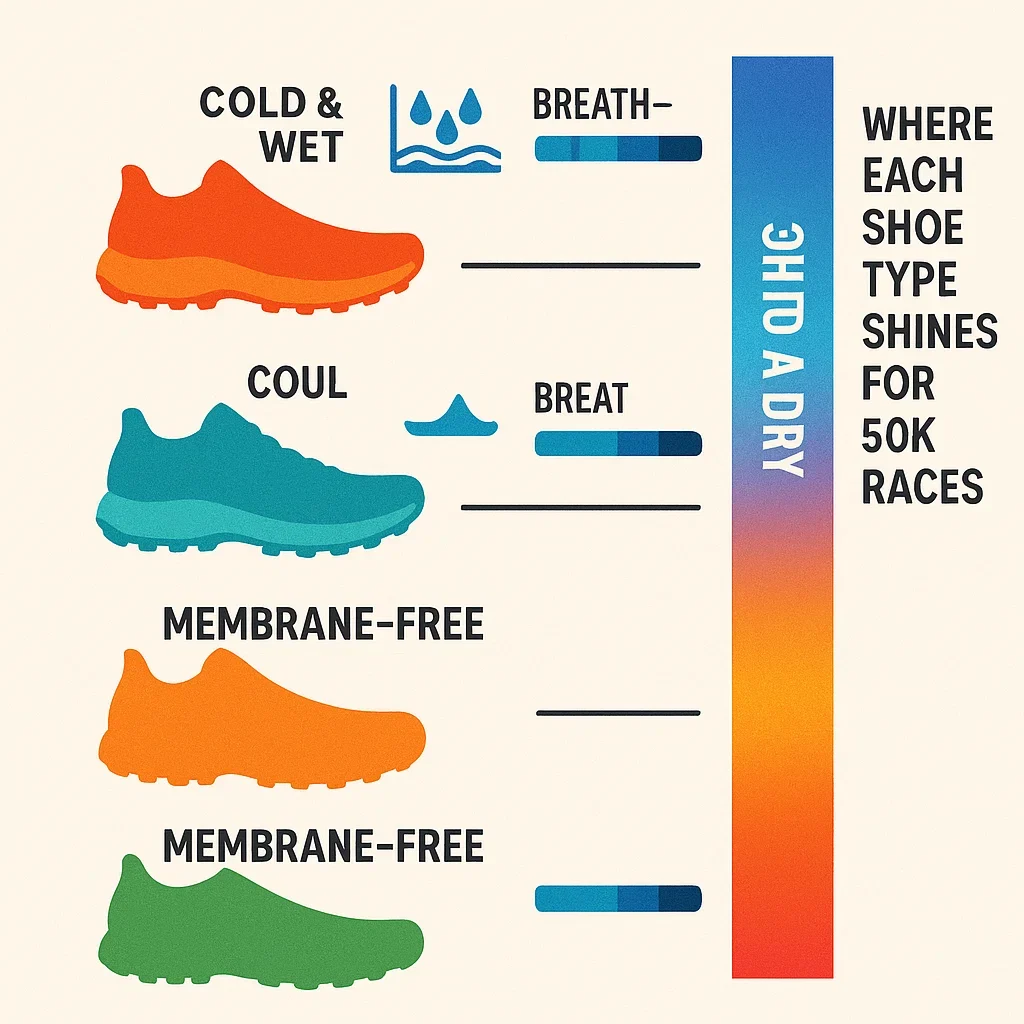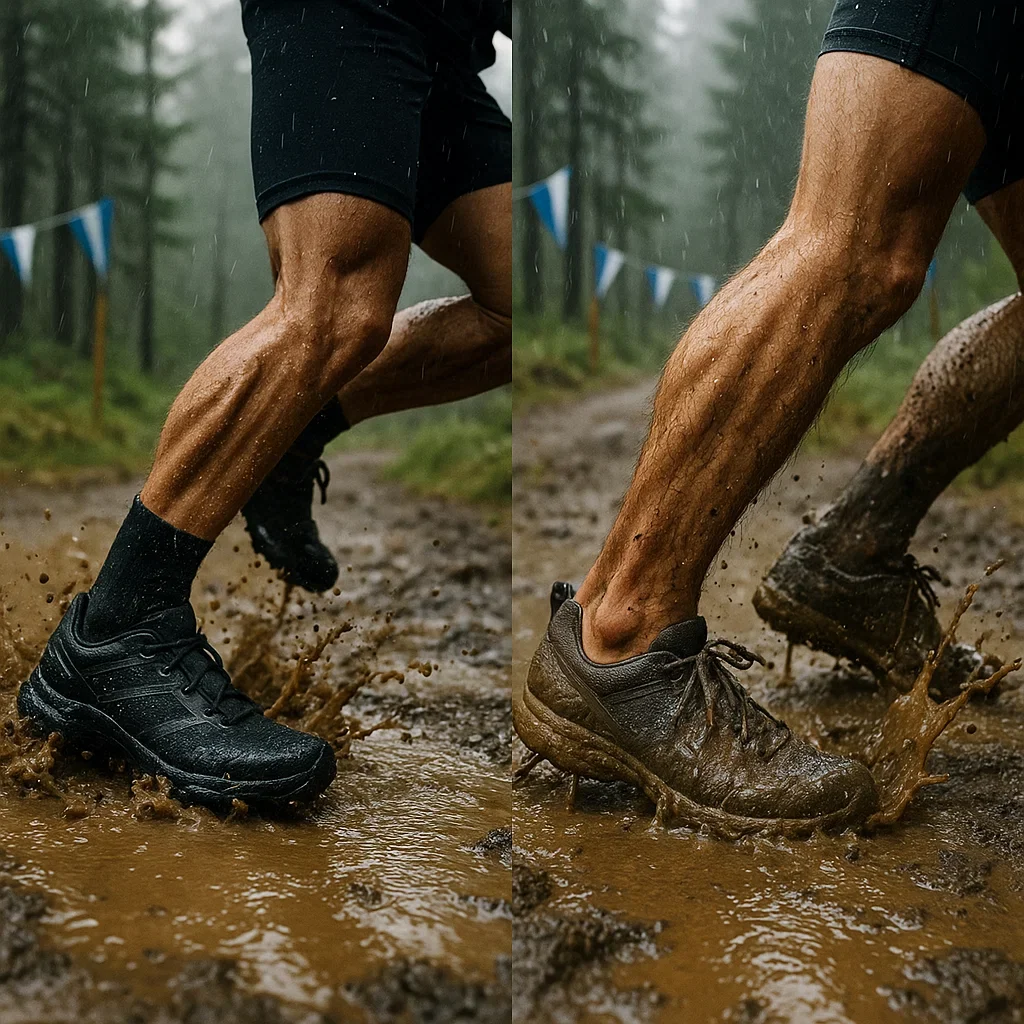Do you really need waterproof trail running shoes for your 50K ultra?
Are they the ultimate race insurance, or a recipe for sweat and blisters?
This is your definitive guide—spanning real-world tests, expert tips, weather science, top models, runner stories, and the decision tools that matter most.
- Pros: Dry feet in puddles, snow, light rain; wind protection; ideal for slow/cold races.
- Cons: Less breathability; sweat can’t escape; heavy when soaked; slow to dry if water gets in.
- Key Question: Is your 50K more likely to be “mud bath” or “steam room”?
🔬 How Waterproof Trail Shoes Actually Work
- Membranes: Most use Gore-Tex, eVent, or Proprietary Tech—these are thin layers sandwiched between outer fabric and lining. They block water droplets, but allow some vapor to escape.
- Water-Repellent Uppers: Durable Water Repellent (DWR) coatings help water bead off the surface—but wear off with use.
- Sealed Seams: Prevent water entry at stitching points—vital for puddle/deep mud crossings.
- Higher Rand & Tongue: Some models add extra “walls” to stop splash entry near the laces/toe.
| Feature | Waterproof | Breathable (Standard) | Hybrid (Drainage Focused) |
|---|---|---|---|
| Water Protection | High | Low | Low–Medium |
| Breathability | Low–Medium | High | High |
| Weight | +20–50g | Baseline | Baseline |
| Dry Speed After Flood | Slow | Very Fast | Fastest |
| Best For | Cold, mud, snow, light rain, walk/hike | Warm, dry, variable, racing | Stream crossings, wet-hot races |
- Consistent rain, wet snow
- Long, cold ultras (risk of numb toes/frostbite)
- Slow pace, lots of hiking/walking
- Wet grass, shallow puddles (not submersion!)
- Chilly wind is a major issue
- Warm, humid races—even if there’s some rain
- Repeated, deep water crossings (floods, rivers)
- Fast pace, racing hard (risk of overheating)
- Prone to foot sweating/blisters
- Want rapid drying after getting wet
🧭 Real-World Scenarios: Should You Go Waterproof in Your 50K?
-
Scenario 1: Cold, Steady Rain (8°C/46°F, all day, muddy forest)
Waterproof shoes shine here—feet stay dry, toes don’t go numb. Breathability is less of an issue at slow pace. Pair with wool socks. Risk: if water spills over the collar, feet may stay wet longer! -
Scenario 2: Hot, Humid, Random Showers (24°C/75°F, variable)
Avoid waterproof shoes. Overheating and sweating causes blisters fast. Standard mesh dries quickly—even if it gets soaked, your feet breathe and recover. -
Scenario 3: Multiple Stream Crossings (mixed temp, rocky trail)
Go with hybrid or standard shoes with excellent drainage. Waterproof shoes will fill with water and not release it, leading to pruney, blistered feet. -
Scenario 4: High Alpine Race (cold wind, occasional snowfields)
Waterproof is useful, especially in early or late season ultras. Wind protection and warmth often matter more than waterproofing per se—pair with gaiters for best effect. -
Scenario 5: Variable Weather, Don’t Know What To Expect
Bring both! Start in regular mesh, pack a waterproof pair in your drop bag. Or carry waterproof socks as backup. Flexibility is king in ultras.
🤔 Decision Flow: Should You Wear Waterproof Shoes in Your 50K?
- Is it cold & wet all day? → Yes: Consider waterproof shoes.
- Will your feet get fully submerged (deep river, lots of flooding)? → No: Go breathable or hybrid.
- Is the pace fast, terrain mixed, and weather variable? → No: Choose breathable, quick-drying shoes.
- Are you prone to cold toes, slow pace, or high wind? → Yes: Waterproof can help.
- Still unsure? → Test both in training. Carry a backup pair or waterproof socks.
🥇 Best Waterproof Trail Running Shoes for 50K Ultra (2025)
| Model | Waterproof Tech | Weight | Best For | Notes |
|---|---|---|---|---|
| Salomon Speedcross 6 GTX | Gore-Tex | 324g | Muddy, wet, cold | Deep lugs, snug fit |
| Hoka Challenger ATR 7 GTX | Gore-Tex | 290g | Mixed terrain, wet/cold | Versatile, soft cushion |
| La Sportiva Blizzard GTX | Gore-Tex | 355g | Snow, slush, wind | Integrated gaiter, winter specialist |
| Merrell MTL Long Sky 2 Waterproof | Proprietary | 302g | All-season, wet rocks | Sticky grip, good drainage |
| Brooks Cascadia 17 GTX | Gore-Tex | 328g | Technical, mountain, variable | Stable, classic ultra model |
| Altra Lone Peak ALL-WTHR | eVent | 322g | Zero drop, wide fit, wet | Flexible, “natural” ride |

🗣️ Real Runner Experiences: Waterproof Shoes on Race Day
– Maria, 50K finisher in Norway
– Evan, mountain trail runner
– Alex, tropical ultra racer
| Runner | Course/Weather | Waterproof? | Result | Lesson Learned |
|---|---|---|---|---|
| Maria | Cold, rainy, forest, 5°C | Yes | Warm, dry feet; heavy after river | Perfect in cold rain, not for full submersion |
| Evan | Muddy, sunny, 14°C → 22°C | Both | Too hot after weather changed | Swapping shoes at halfway helps |
| Alex | Tropical, humid, muddy | Yes (then No) | Blistered in waterproof, fine in mesh | Never waterproof in humid ultras |
🧑🔬 Expert Opinion: Are Waterproof Shoes Overrated in Ultras?
“Waterproof membranes are double-edged: a savior in freezing rain, but an enemy in heat and long, wet races. Most experienced ultra runners avoid them unless it’s truly cold, slow, or the risk of wind-chill is high. For variable weather, bring waterproof socks or a backup pair for drop bags. The golden rule: test in training, not on race day!”
— Jamie Lin, trail running coach & gear tester
⚠️ Common Mistakes & Pro Tips for Waterproof Shoes in 50K
- Mistake: Picking waterproof “just in case.” Tip: Know the actual weather and terrain—you may never need them!
- Mistake: Ignoring fit: waterproof models fit tighter (less stretch). Tip: Try on with race socks—size up if needed.
- Mistake: Racing in waterproof shoes for the first time. Tip: Always do at least one long, wet training run before committing.
- Mistake: Assuming “waterproof” means “dry feet all day.” Tip: Water can always enter from above—consider gaiters for deep mud/snow!
- Mistake: Not drying shoes fully after wet races. Tip: Remove insoles and stuff with newspaper to absorb moisture overnight.
🧼 Waterproof Shoe Care & Race Day Tactics
- After muddy races: Rinse shoes ASAP with cool water; avoid hot water which can damage membranes.
- Drying: Pull out insoles/laces, stuff with paper towels/newspaper. Never direct heat (no radiators or dryers).
- Restoring DWR: Use spray-on or wash-in Durable Water Repellent every few races to keep outer layer beading water.
- Race Day: Bring a backup pair or waterproof socks for big temperature swings or wet/cold finishes.
- Gaiters: Pair waterproof shoes with trail gaiters in snow or heavy mud to stop water/debris from entering the collar.
❓ Advanced FAQ: Waterproof Trail Shoes in 50K Ultras
🌧️ How “waterproof” is waterproof in trail running shoes?
🔥 Will my feet overheat in waterproof shoes?
🧦 What socks work best in waterproof shoes?
🩹 Can I use waterproof socks instead of shoes?
🏃 What if my feet get wet during a 50K?
📚 Further Reading
Final Thoughts
Waterproof trail shoes are a powerful tool—when you truly need them. They’re not always the best default for every 50K ultra. Know your race, know your feet, and always test in advance. The smartest runners bring options and adapt to the day. Stay prepared, stay moving, and keep your adventure fun—rain or shine!

About the Author
Lost Pace is an ultramarathon runner, shoe-tester and the founder of umit.net. Based year-round in Türkiye’s rugged Kaçkar Mountains, he has logged 10,000 + km of technical trail running and completed multiple 50 K–100 K ultras.
Blending mountain grit with data, Lost analyses power (CP 300 W), HRV and nutrition to craft evidence-backed training plans. He has co-written 260 + long-form guides on footwear science, recovery and endurance nutrition, and is a regular beta-tester of AI-driven coaching tools.
When he isn’t chasing PRs or testing midsoles, you’ll find him sharing peer-reviewed research in plain English to help runners train smarter, stay healthier and finish stronger.
Ultrarunner · Data geek · Vegan athlete

